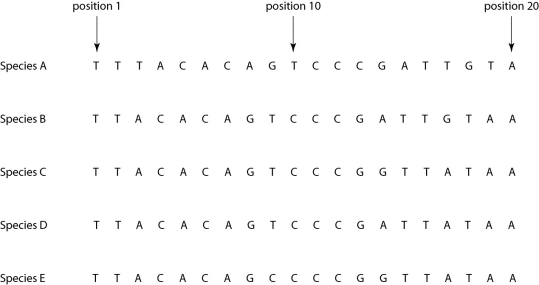Multiple Choice

Figure 26.3. Morphologically, species A is very similar to four other species, B-E. Yet the nucleotide sequence deep within an intron in a gene shared by all five of these eukaryotic species is quite different in species A compared to that of the other four species when we study the nucleotides present at each position.
-If the sequence of species A in Figure 26.3 differs from that of the other four species due to simple misalignment, then what should the computer software find when it compares the sequence of species A to those of the other four species?
A) The nucleotide at position 1 should be different in species A, but the same in species B-E.
B) The nucleotide sequence of species A should have long sequences that are nearly identical to those of the other species, but offset in terms of position number.
C) The sequences of species B-E, though different from that of species A, should be identical to each other, without exception.
D) If the software compares the amino acid sequence of the actual protein product rather than the nucleotide sequence, then the amino acid sequences of species B-E should be similar to each other, but very different from that of species A.
E) Computer software is useless in determining sequences of introns; it can only be used with exons.
Correct Answer:

Verified
Correct Answer:
Verified
Q30: From Figure 26.5, which other event occurred
Q31: Traditionally, zoologists have placed birds in their
Q32: Which of the following is (are)problematic when
Q33: Which of these would, if it had
Q34: The most important feature that permits a
Q36: Traditionally, whales and hippopotamuses have been classified
Q37: Which of the following items does not
Q38: The following questions refer to this phylogenetic
Q39: The next questions refer to the following
Q40: Traditionally, zoologists have placed birds in their